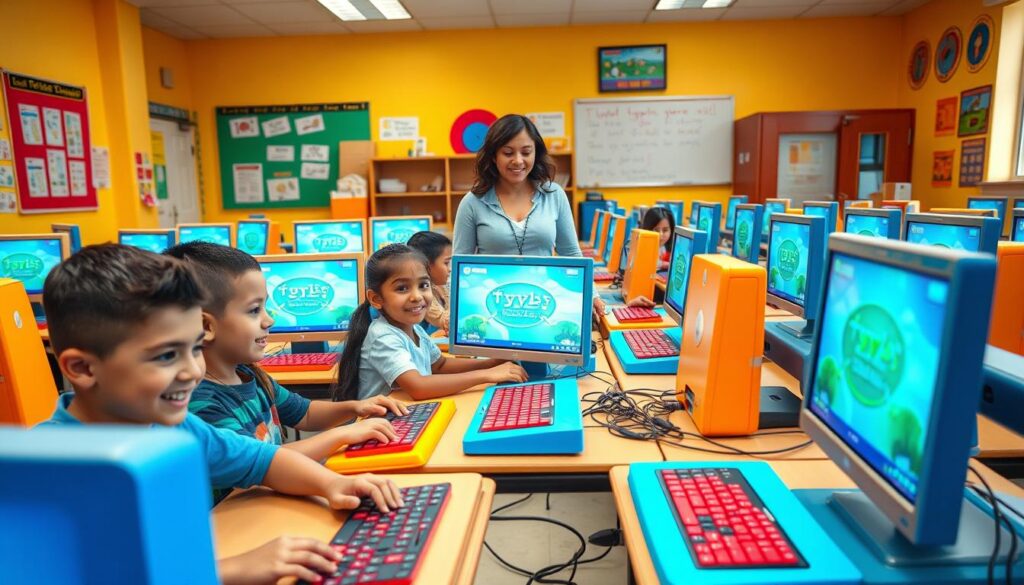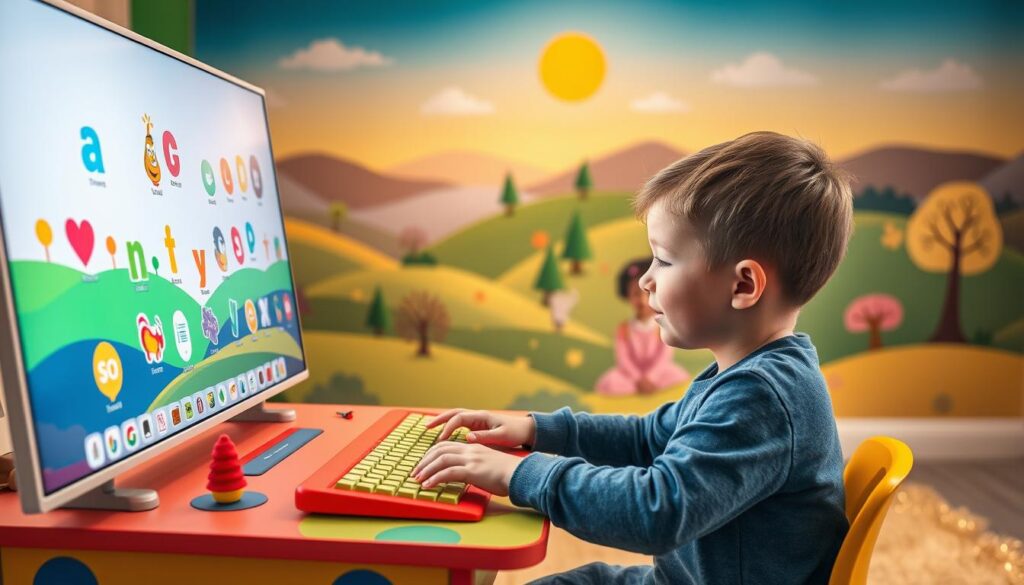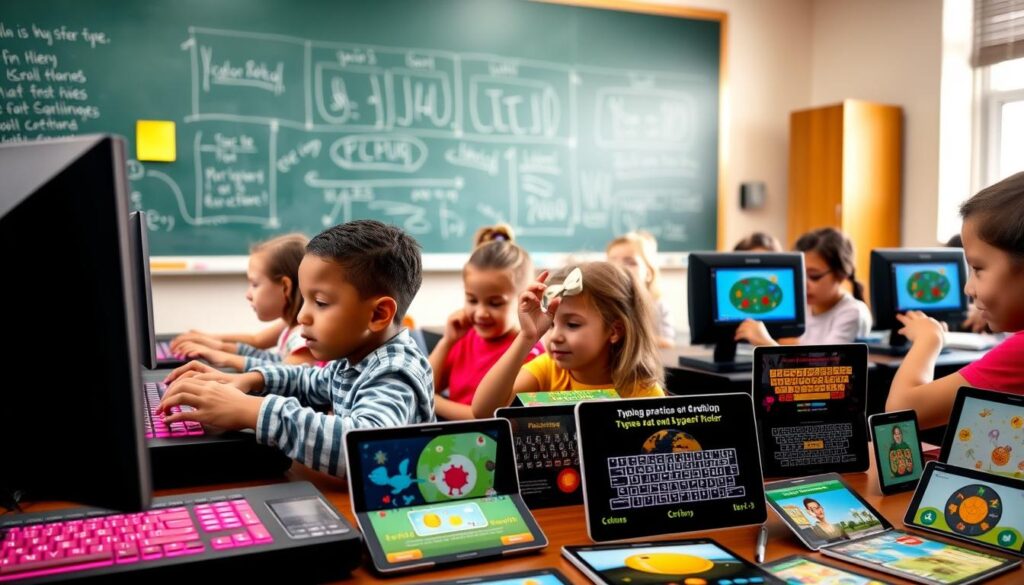Top Typing Games for Children: Improve Your Kid’s Keyboard Learning
Are you looking for a fun way to help your child learn to type? In today’s world, typing skills are key for success in school and life.
There are many educational typing games out there. Games like TypingClub, Dance Mat Typing, and Nitrotype make learning fun. They help kids improve their keyboard skills.
These typing games for kids are not just fun. They also teach kids how to use the keyboard well. By using these games every day, your child will become more confident and skilled at typing.
Key Takeaways
- Discover the most effective typing games for improving your child’s keyboard skills.
- Learn about popular keyboard learning apps designed for children.
- Understand the benefits of using educational typing games for kids.
- Find out how to make typing practice a fun and engaging experience.
- Explore the top educational typing games that can help your child succeed.
Why Typing Games are Essential for Kids
Typing games are a fun way for kids to learn keyboard skills. They make learning to type enjoyable, not a chore.
“Typing is a fundamental skill that every child needs to succeed in today’s digital world,” says a renowned educational expert. This highlights the importance of interactive keyboard practice for kids.
Benefits of Early Keyboard Skills
Learning to type early has many benefits. It improves hand-eye coordination, vocabulary, and spelling. Fun typing games help kids develop these skills in a fun way.
Early keyboard skills are key for future success. As kids grow, they’ll need to type for schoolwork. Learning to type early helps them do this well.
Enhancing Learning Through Play
Typing games for beginners are designed to be fun and engaging. They make kids want to practice typing, improving their skills.
These games also boost fine motor skills, hand-eye coordination, and thinking abilities. As kids progress, they become more confident and positive about learning.
Using fun typing games, parents can help kids practice typing regularly. This makes them proficient typists, ready for future challenges.
Popular Typing Games for Kids
There are many typing games for kids to improve their typing skills. These games are both fun and educational. They suit different learning styles and preferences.
TypingClub: An Interactive Learning Experience
TypingClub is a fun and interactive typing game. It offers lessons that get harder as you go. The game’s interactive interface keeps kids engaged, making learning fun.
Dance Mat Typing: Fun and Engaging
Dance Mat Typing is a popular game that mixes fun with learning. It’s designed for younger kids and uses a dance mat theme. The game’s engaging nature helps kids stay motivated as they progress.
Nitrotype: Racing to Improve Speed
Nitrotype is a game that focuses on speed and accuracy. It has a fun racing theme. Players compete in typing races, which helps improve their typing speed and accuracy. The competitive aspect motivates kids to practice regularly.
These typing games are not only fun but also educational. They add elements of fun and competition. This helps kids develop essential typing skills for school and work.
Keyboard Learning Apps for Children
Keyboard learning apps are changing how kids learn to type. They make it fun and engaging. These apps have interactive features and tools tailored for kids to improve their typing skills.
ABCya! Typing: Educational and Fun
ABCya! Typing is loved by parents and teachers. It’s educational and entertaining. The app has lessons that get harder as you progress.
It has typing games and activities to keep kids interested. You can see how well a child is doing and where they need to get better.
Typing.com: Comprehensive Learning Tool
Typing.com is a top choice for learning to type. It teaches the basics like finger placement and speed. It’s a comprehensive typing curriculum.
The app has fun lessons and games. It also gives detailed reports on a child’s progress. This helps parents see how their child is improving.
Keybr.com: Personalized Typing Practice
Keybr.com focuses on personalized typing practice. It adjusts lessons based on how well a child is doing. This makes sure they’re always learning at the right level.
It has many typing exercises and games. This keeps kids interested and engaged in their learning.
| App Name | Key Features | Age Suitability |
|---|---|---|
| ABCya! Typing | Structured lessons, progress tracking, typing games | 6-12 years |
| Typing.com | Comprehensive curriculum, interactive lessons, progress reports | 5-18 years |
| Keybr.com | Personalized practice, adaptive learning, typing exercises | 7-14 years |
Experts say the best typing instruction combines fun content, feedback, and learning steps. These apps do just that, giving kids a strong typing foundation.
“The key to successful typing instruction is a combination of engaging content, personalized feedback, and progressive learning pathways.”
Engaging Game Features to Look For
When picking a typing game for your child, look for features that make it fun and effective. Fun typing games mix fun with learning, making it a joy to learn. They offer interactive keyboard practice to help your child get better at typing.
Colorful Graphics and Animation
Colorful graphics and animations grab a child’s attention and keep them interested. Games with bright visuals and fun animations make learning fun and interactive. This makes learning more effective as your child stays engaged.
Rewards and Progress Tracking
Rewards and tracking progress are key in typing games, even for beginners. Typing games for beginners use rewards to keep kids practicing and improving. Seeing their progress motivates them to keep going.
By adding these features, typing games offer a fun and complete learning experience. Choose games that are both fun and educational to keep your child excited about learning.
How to Choose the Right Typing Game
Finding the right typing game for your child can be tough. It’s important to look at their typing skills first. The right typing game for kids can really help them learn.
Assessing Your Child’s Skill Level
Start by figuring out your child’s typing level. Are they just starting, getting better, or already good? Knowing this helps you pick the right game. Look for games that test their skills at the start.
Games like TypingClub and Nitrotype have tests to see how good your child is. These educational typing games adjust to your child’s speed. This keeps them from getting too easy or too hard.
| Skill Level | Characteristics | Recommended Games |
|---|---|---|
| Beginner | Lack basic keyboard familiarity | TypingClub, ABCya! Typing |
| Intermediate | Can type with some accuracy | Nitrotype, Typing.com |
| Advanced | High speed and accuracy | Keybr.com, Typing.com |
Considering Age Appropriateness
It’s also key to pick a game that’s right for your child’s age. Younger kids need games with bright colors and easy-to-use interfaces. Older kids might like games with harder lessons.
When picking a typing game for students, think about the game’s content. Does it match your child’s age and interests? For example, Dance Mat Typing is great for young kids because it’s fun. Typing.com has lessons for kids of many ages.
By looking at your child’s skill and age, you can find a typing game that’s fun and helps them learn. This careful choice will make learning fun and effective.
Tips to Encourage Your Child to Practice
To help your child become a proficient typist, make practice a regular and fun part of their routine. Encourage them to practice by setting a schedule and making it enjoyable.
Setting a Regular Schedule
Having a regular practice schedule helps create a habit and ensures progress. Allocate a specific time each day for typing practice, even if it’s just a few minutes. This consistency is key to improving typing skills.
- Choose a quiet, distraction-free area for practice.
- Set a timer to keep practice sessions short and focused.
- Use a calendar or planner to track practice days.
Rewarding Progress and Achievements
Rewarding your child’s progress can be a great motivator. Positive reinforcement through rewards can encourage them to keep practicing and improving their typing skills.
| Progress Milestone | Reward Idea |
|---|---|
| Completing a certain number of practice sessions | Extra storytime or a special outing |
| Achieving a new typing speed record | A fun activity or game of their choice |
| Mastering a difficult typing level | A small gift or privilege |
By combining a regular practice schedule with rewards, you can create an environment that encourages your child to practice typing regularly. They will have fun while doing it.
The Importance of Proper Hand Positioning
To become good typists, kids need to learn how to place their hands correctly. This skill is key for typing well and avoiding mistakes. It’s about placing fingers on the home row keys without looking at the keyboard.
Teaching Home Row Keys
The home row keys are the middle row of keys on the keyboard. They are where fingers rest in a neutral position. Teaching kids to place their fingers correctly on these keys is vital.
The home row keys for the left hand are A, S, D, and F. For the right hand, they are J, K, L, and . Many typing games for beginners use fun lessons to teach these keys.
Some good ways to teach home row keys include:
- Using interactive keyboard practice exercises that highlight the home row keys.
- Incorporating games that require kids to type specific keys or sequences.
- Providing visual aids and keyboard overlays to help kids identify the correct finger placement.
Integrating Hand Positioning in Games
Typing games can make learning hand positioning fun. Many keyboard learning apps for children have games that require proper hand positioning. These games give feedback on finger placement, helping kids improve their typing posture.
Look for games with these features:
- Guided tutorials that show correct finger placement.
- Exercises that focus on specific fingers or hand positions.
- Progress tracking that rewards improvement in hand positioning and typing accuracy.
By teaching hand positioning in typing games for beginners, kids can start with good typing habits. This improves their typing skills and makes learning fun and interactive.
Measuring Your Child’s Typing Progress
Knowing how to track your child’s typing progress is key to their learning. As they play typing games and practice, it’s important to see how they’re doing.
Speed and Accuracy Metrics
Typing games and apps often give speed and accuracy metrics. These include words per minute (wpm), accuracy percentage, and error rates. By looking at these, you can see where your child needs more practice.
If your child’s accuracy is low, they might need to work on it more. But if they’re accurate but slow, you could help them speed up.
Using Built-in Assessments
Most typing games and apps have built-in assessments to check a child’s typing. These assessments are great for seeing how much they’ve improved over time.
Some games give detailed reports on how well a child is doing. For example, they might show where a child is struggling or needs to type faster.
| Assessment Criteria | Description | Improvement Strategies |
|---|---|---|
| Speed | Words per minute (wpm) | Practice timed typing exercises |
| Accuracy | Percentage of correctly typed words | Focus on precise keystrokes, slow down |
| Error Rate | Number of errors per minute | Review common mistakes, practice error correction |
By using these built-in assessments and focusing on important metrics, you can help your child get better at typing.
Combining Typing Games with Other Educational Tools
To give a well-rounded education, mix typing games with other tools. This way, you can make learning fun and effective. It boosts your child’s school performance.
Integrating Typing with Language Arts
Linking typing games with language arts is smart. Many games teach typing and language skills at the same time. Kids learn grammar, vocabulary, and comprehension while typing.
Benefits of Integration:
- Improved reading and writing skills
- Enhanced vocabulary
- Better comprehension and grammar
Enhancing STEM Learning with Coding Games
Integrating typing games with coding is also great. Coding games boost problem-solving, thinking, and creativity. They also improve typing skills. Kids type out code, which helps them learn the keyboard.
| Subject | Benefits | Examples of Games |
|---|---|---|
| Language Arts | Improved reading, writing, vocabulary, comprehension, and grammar | TypingClub, Dance Mat Typing |
| STEM/Coding | Problem-solving, logical thinking, creativity, and typing skills | Nitrotype, CodeCombat |
By mixing typing games with other tools, you create a fun learning space. It supports your child’s growth in all areas of education.
Future of Typing Skills in Education
Technology keeps getting better, making typing skills more important in school. You know that typing well is now a must for your child to do well in school.
Role of Technology
Technology is changing how we learn, and typing is key to moving through this digital world. With online learning, typing games, and apps, your child can get the typing skills they need to shine.
Preparing for a Digital Future
Adding typing games to their schoolwork can keep your child ahead. These games make learning fun and give your child the digital skills they’ll need.



